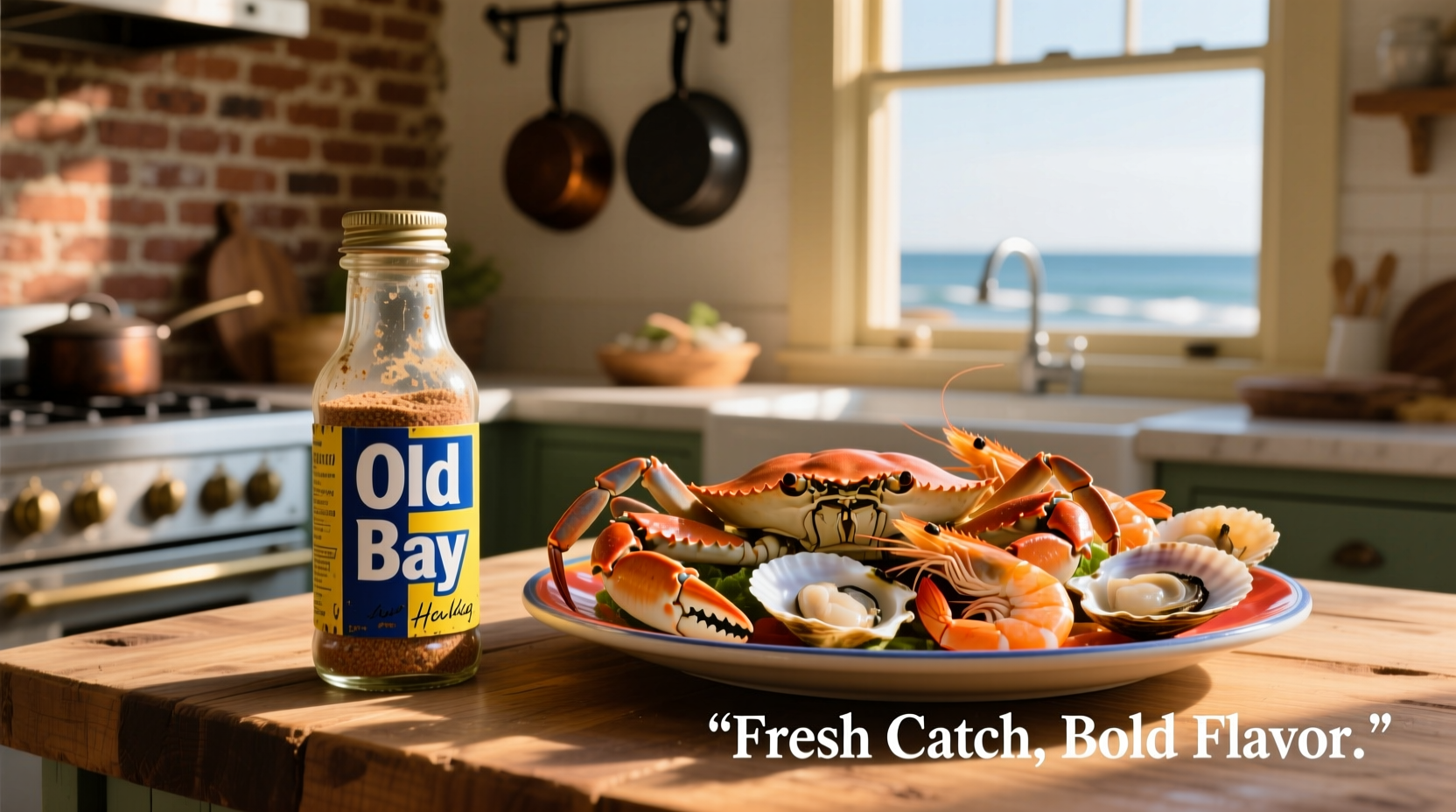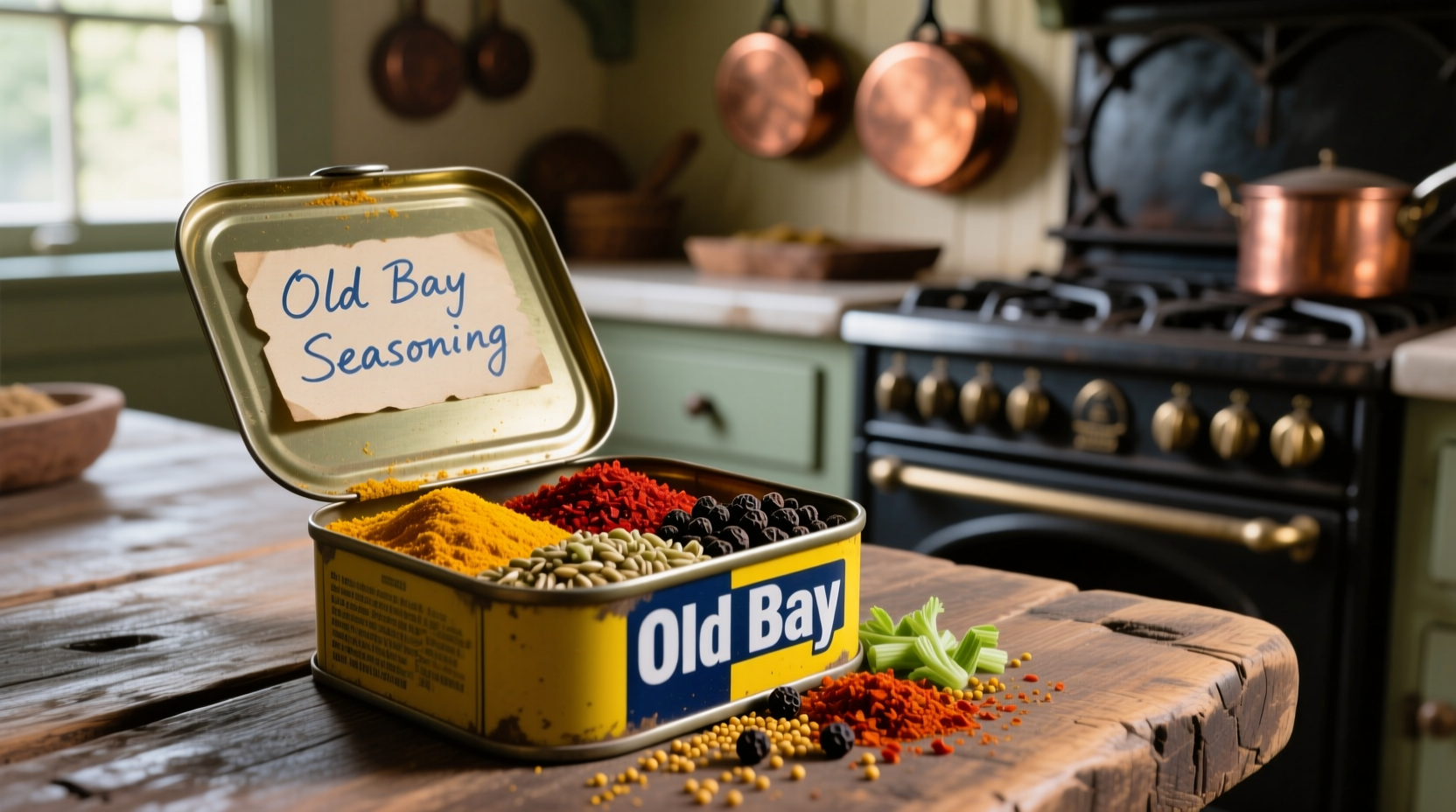For decades, home cooks and professional chefs alike have reached for that familiar yellow can when preparing seafood. But what exactly gives Old Bay its unmistakable flavor? Understanding the specific spices in this iconic blend isn't just trivia—it's the key to using it effectively in your cooking and even creating your own custom versions when needed.
The Complete Spice Breakdown of Old Bay Seasoning
While McCormick & Company keeps the exact proportions of Old Bay seasoning a closely guarded secret, the official ingredient list reveals the precise components that create this beloved blend. Unlike many commercial spice mixes that hide their components under vague terms like "spices" or "natural flavors," Old Bay clearly lists each element:
| Spice | Flavor Profile | Primary Contribution |
|---|---|---|
| Celery salt | Savory, herbal, slightly bitter | Base flavor and salt component |
| Paprika | Earthy, sweet, mild heat | Color and subtle warmth |
| Black pepper | Sharp, pungent, woody | Background heat and complexity |
| Cayenne pepper | Sharp, immediate heat | Spicy kick |
| Cloves | Warm, sweet, slightly medicinal | Distinctive aromatic note |
| Allspice | Complex blend of cinnamon, nutmeg, clove | Depth and warmth |
| Ginger | Sharp, citrusy, mildly spicy | Brightening element |
What makes Old Bay particularly interesting is how these components work together. The celery salt forms the foundation, providing both saltiness and that characteristic celery note that defines the blend. Paprika delivers color and subtle warmth without overwhelming heat. Black pepper and cayenne work in tandem—one providing background complexity, the other delivering that signature kick. The warm spices (cloves, allspice, and ginger) create a distinctive aromatic profile that sets Old Bay apart from other seafood seasonings.
How Old Bay's Spice Profile Evolved Over Time
Old Bay's spice composition hasn't remained completely static since its creation. Understanding its evolution helps explain why certain spices made the final cut:
| Time Period | Spice Composition | Historical Context |
|---|---|---|
| 1939-1940s | Original formulation by Gustav Brunn | Born from Brunn's German-Jewish culinary background combined with Chesapeake Bay seafood traditions |
| 1950-1960s | Standardized commercial formulation | Increased popularity led to consistent production methods |
| 1990s | Minor adjustments for mass production | Mccormick acquisition brought slight formulation tweaks while maintaining core profile |
| Present Day | Consistent with late 20th century version | Recognized as authentic Chesapeake Bay flavor profile |
Gustav Brunn, a German Jewish immigrant and spice blender, created the original blend in 1939 after fleeing Nazi Germany. According to The Baltimore Sun, Brunn initially called it "Delicious Brand Shrimp and Crab Seasoning" before renaming it after the Old Bay Line, a passenger ship line that ran between Baltimore and Norfolk. The blend was designed specifically for the seafood abundant in the Chesapeake Bay region, explaining why it works so perfectly with blue crabs, shrimp, and other local catches.
When and How to Use Old Bay's Unique Spice Blend
Understanding the specific spices in Old Bay helps you use it more effectively. This blend works best in certain contexts and can be problematic in others:
- Perfect applications: Steamed crabs, shrimp boils, fish fries, potato salads, and remoulade sauces
- Limited effectiveness: Delicate fish like sole or flounder where the strong spices might overwhelm
- Potential issues: High-sodium diets (due to celery salt base) or when serving those sensitive to cloves
- Pro tip: For more control, toast whole spices and grind your own blend when preparing special occasions
Food science research from the USDA National Institute of Food and Agriculture shows that the volatile compounds in Old Bay's spices—particularly the ginger and black pepper—release more flavor when heated gradually rather than added at the end of cooking. This explains why the traditional method of boiling Old Bay with seafood yields better results than simply sprinkling it on afterward.
Practical Tips for Maximizing Old Bay's Flavor Profile
Now that you know exactly what spices make up Old Bay, here's how to get the most from each component:
- Storage matters: Keep your Old Bay in an airtight container away from light. The paprika and cayenne will lose potency fastest when exposed to air.
- Timing is everything: Add Old Bay early when boiling (to allow flavors to penetrate) but later when roasting (to preserve volatile compounds).
- Balance the heat: If the cayenne is too intense for your taste, balance it with a touch of honey or brown sugar in your preparation.
- Make it your own: Try adding a pinch of smoked paprika for depth or a dash of lemon zest to brighten the existing ginger notes.

Professional chefs at the Culinary Institute of America note that Old Bay's distinctive clove note is what makes it uniquely American. While many global spice blends use cloves sparingly, Old Bay features it prominently—a reflection of 19th century American spice preferences documented in historic cookbooks like Seven Hundred Recipes (1870). This distinctive element explains why Old Bay tastes different from similar European or Caribbean seafood blends.
Creating Your Own Old Bay Substitute
When you run out of Old Bay or want to customize the blend, knowing the exact spices allows you to create a close approximation. Here's a professional chef's ratio based on reverse-engineering the flavor profile:
- 3 parts celery salt
- 1 part paprika
- ½ part black pepper
- ¼ part cayenne pepper
- ⅛ part ground cloves
- ⅛ part allspice
- ⅛ part ginger
For best results, toast the whole spices (except celery salt) in a dry pan over medium-low heat for 1-2 minutes until fragrant, then grind them together before mixing with the celery salt. This process activates the essential oils and creates a more vibrant flavor than pre-ground spices alone.
Frequently Asked Questions About Old Bay Spices
Does Old Bay contain MSG?
No, Old Bay seasoning does not contain monosodium glutamate (MSG). The ingredient list consists only of the spices mentioned plus salt from the celery salt component. McCormick's official product information confirms the absence of MSG in Old Bay.
Is Old Bay gluten-free?
Yes, Old Bay seasoning is naturally gluten-free as it contains only spices and salt. However, those with severe gluten sensitivity should check the packaging for potential cross-contamination warnings, as manufacturing facilities may process other products containing gluten.
Why does Old Bay taste different in various regions?
Old Bay's flavor consistency is carefully maintained, but perception can vary due to regional palates. According to sensory research from the Institute of Food Technologists, consumers in the Mid-Atlantic region (where Old Bay originated) are more accustomed to its distinctive clove note, while those in other regions might perceive it as stronger or more unusual.
Can I make Old Bay without celery salt?
While celery salt is fundamental to Old Bay's flavor profile, you can substitute with 1 part table salt plus 1 part dried celery flakes. However, this won't perfectly replicate the flavor, as celery salt contains both the salt and the distinctive celery seed flavor that defines Old Bay's base note.
Does Old Bay expire?
Spice blends don't technically expire but lose potency over time. Old Bay maintains best flavor for 1-2 years when stored properly in a cool, dark place. The paprika and cayenne will fade first, followed by the more volatile spices like ginger and black pepper. You'll notice when it's time to replace your Old Bay if the vibrant red color has faded and the aroma has weakened.











 浙公网安备
33010002000092号
浙公网安备
33010002000092号 浙B2-20120091-4
浙B2-20120091-4